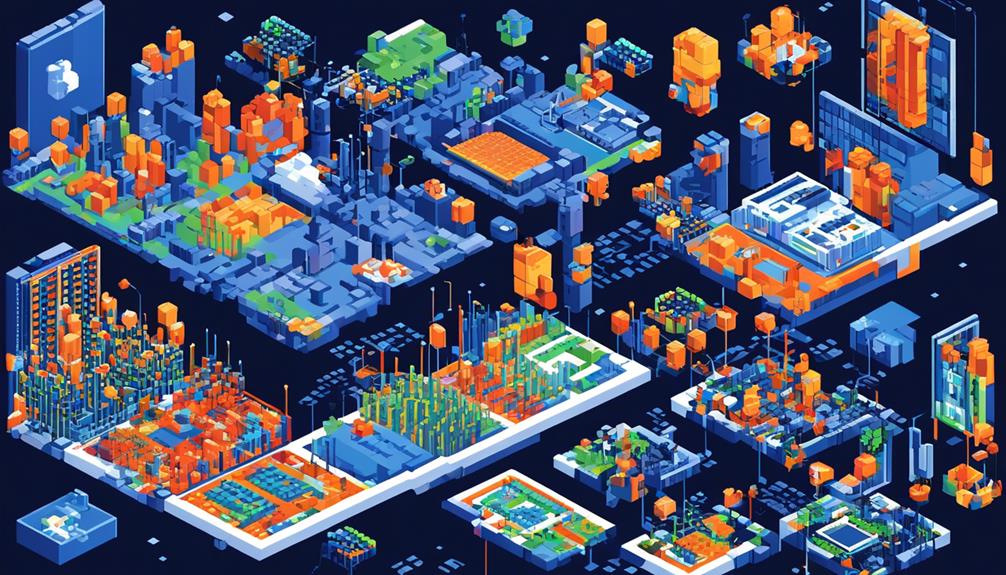Wireless hardware technology continues to evolve at a rapid pace, ushering in a new era of connectivity and innovation. From the advent of 5G networks to the emergence of advanced wireless technologies like V2X and wireless power transfer, the latest trends in this field are shaping the future of communication and revolutionizing various industries.
Alongside these developments, the integration of artificial intelligence and edge computing is poised to unlock unprecedented potential. As we delve into the world of wireless hardware technology, it becomes evident that the possibilities are vast and the opportunities for growth are immense.
Key Takeaways
- 5G networks and IoT are key drivers in wireless hardware technology, enabling faster and more connected devices.
- Artificial intelligence integration is enhancing wireless hardware performance, making networks more efficient and capable of handling advanced tasks.
- Emerging technologies such as augmented reality, Li-Fi, and mmWave communication are expanding the possibilities of wireless communication.
- Network control and management techniques like SDN and NFV are revolutionizing the way networks are controlled and operated, increasing flexibility and scalability.
5G Networks

5G Networks revolutionize wireless communication by providing unprecedented performance and capabilities. They boast data rates of up to 10 Gbps, latency as low as 1 ms, and network capacity 100 times greater than 4G. This advancement in wireless technology is a significant milestone in telecommunications, addressing the increasing demand for faster and more reliable connectivity.
One of the key features of 5G networks is its ability to provide high data rates. With data rates of up to 10 Gbps, users can experience ultra-fast download and upload speeds, allowing for seamless streaming, quick file transfers, and lag-free gaming. This is a substantial improvement over the capabilities of 4G networks, which typically offer data rates of around 100 Mbps. The increased data rates of 5G networks enable a wide range of applications and services that require large amounts of data to be transmitted and processed in real-time.
Another significant advantage of 5G networks is their low latency. With latency as low as 1 ms, they minimize the delay between when a data packet is sent and when it is received, resulting in a more responsive and interactive user experience. This low latency is particularly crucial for applications that require real-time communication, such as autonomous vehicles and remote medical procedures. By reducing the latency, 5G networks enable faster decision-making and enhance the efficiency and safety of these applications.
Additionally, 5G networks offer a network capacity that is 100 times greater than 4G networks. This increased capacity allows for more devices to be connected to the network simultaneously without experiencing congestion or degradation in performance. With the rise of the Internet of Things (IoT) and the proliferation of connected devices, this enhanced network capacity is essential to support the massive number of devices that will be connected in the future.
Internet of Things (IoT)
The Internet of Things (IoT) has revolutionized the way we interact with our homes, with the rise of smart home devices. These devices, such as smart thermostats and security systems, enable us to control and monitor our homes remotely, enhancing convenience and security.
Additionally, wearable technology has become increasingly popular, with devices like smartwatches and fitness trackers seamlessly integrating into our daily lives, providing us with personalized health and fitness data.
Moreover, the IoT has paved the way for connected vehicles, enabling advanced features such as real-time navigation updates and remote vehicle diagnostics.
Smart Home Devices
How do smart home devices, also known as Internet of Things (IoT) devices, utilize wireless technology to enhance convenience and efficiency in the home?
Smart home devices leverage wireless connectivity to provide seamless control and monitoring of various household appliances and systems. These IoT devices, ranging from smart thermostats to security systems, rely on wireless technologies like Wi-Fi, Bluetooth, Zigbee, and Z-Wave to enable communication and interoperability within the smart home ecosystem.
The integration of wireless hardware technology has enabled these devices to offer improved connectivity, energy efficiency, and enhanced user experiences. With low power consumption and the ability to connect to a central hub or smartphone, smart home devices have become an integral part of modern home automation, transforming the way we interact with and manage our homes.
Wearable Technology
Wearable technology, a subset of the Internet of Things (IoT), revolutionizes the way users monitor their health, communicate, and enhance productivity through the integration of smart, connected devices. These wireless devices seamlessly integrate into daily life, providing real-time data and convenience. Examples of wearable technology include smartwatches, fitness trackers, smart glasses, and augmented reality headsets. These devices leverage sensors, connectivity, and data processing to deliver personalized experiences and insights. The intersection of wearable technology and IoT is driving innovation in healthcare, fitness, fashion, and workplace productivity. By harnessing wireless technologies, wearable devices enable users to track their health and fitness goals, receive notifications and calls, access information on-the-go, and even interact with virtual and augmented reality environments. The future of wearable technology holds immense potential for transforming various industries and enhancing user experiences.
| Wearable Technology | Benefits |
|---|---|
| Smartwatches | Fitness tracking, notifications, calls |
| Fitness trackers | Health monitoring, activity tracking |
| Smart glasses | Augmented reality, hands-free information |
| Augmented reality headsets | Immersive experiences, virtual interaction |
Connected Vehicles
Connected Vehicles, a key component of the Internet of Things (IoT), revolutionize transportation by enabling vehicles to communicate with each other and with infrastructure, enhancing safety and efficiency on the road. This is made possible through the implementation of wireless communication systems in vehicles.
Connected vehicles utilize IoT technology to enable real-time data exchange, allowing for features like predictive maintenance and personalized services. One such technology that empowers connected vehicles is V2X Technology (Vehicle-to-Everything). V2X enables vehicles to communicate not only with each other but also with various elements in their environment, such as pedestrians, traffic lights, and other vehicles. This connectivity facilitates advancements like autonomous driving and smart transportation systems.
Additionally, cellular IoT, specifically LTE-M and NB-IoT, plays a crucial role in providing reliable and widespread connectivity for connected vehicles, further enhancing their capabilities.
As connected vehicles continue to evolve, they promise to play a significant role in shaping the future of transportation and smart cities.
Edge Computing
Edge Computing is a crucial technology that processes data closer to the source, enabling quicker response times and reducing latency. It plays a vital role in the realm of wireless technologies, as it allows for real-time data analysis applications and the development of new applications and services. By processing data closer to the source, Edge Computing ensures that critical data is analyzed and acted upon immediately, without the need for sending it to a centralized data center.
One of the key benefits of Edge Computing is its ability to support the Internet of Things (IoT). With the rapid growth of IoT devices, there is a need for efficient and fast data processing. Edge Computing addresses this need by processing data at the edge of the network, eliminating the need to transfer large amounts of data to a remote data center. This not only reduces latency but also minimizes bandwidth usage.
Moreover, Edge Computing opens up new avenues for innovation by enabling the creation of new applications and services. With the capability to process data in real-time, businesses can develop applications that require immediate response and decision-making. This technology is particularly useful in scenarios such as industrial automation, autonomous vehicles, and smart cities, where low latency and quick response times are essential.
As Edge Computing continues to evolve, it is increasingly being integrated into wireless hardware technology. This integration allows for efficient and effective real-time data processing, ensuring that critical decisions can be made without any delay.
Artificial Intelligence (AI) Integration

The integration of Artificial Intelligence (AI) into wireless hardware technology revolutionizes operations and enhances user experiences. By leveraging AI and machine learning algorithms, wireless networks can now offer predictive maintenance and personalized customer experiences. This integration enables telecom providers to understand user preferences and deliver tailored services based on data analytics.
One of the key benefits of AI integration in wireless hardware technology is its ability to predict network congestions and efficiently reroute traffic. By analyzing real-time data, AI algorithms can identify potential bottlenecks and dynamically optimize network resources to ensure smooth and uninterrupted connectivity. This not only improves network performance but also enhances user experiences by reducing latency and packet loss.
Moreover, AI integration empowers telecom providers to offer personalized services to their customers. By analyzing vast amounts of data, AI algorithms can gain insights into user behavior, preferences, and usage patterns. This information can then be used to offer personalized recommendations, promotions, and targeted advertisements. By tailoring services to individual users, telecom providers can enhance customer satisfaction and loyalty.
To provide a clearer understanding of the benefits of AI integration in wireless hardware technology, the following table highlights some of its key advantages:
| Advantages of AI Integration in Wireless Hardware Technology |
|---|
| Predictive maintenance |
| Personalized experiences |
| Network congestion prediction |
| Data analytics for user preferences |
Wi-Fi 6 and 6E
Wi-Fi 6 and 6E bring significant advancements to wireless technology.
With faster wireless speeds, Wi-Fi 6 delivers higher data rates and increased network capacity, allowing for more efficient and seamless connectivity.
Furthermore, the introduction of Wi-Fi 6E expands the frequency range, opening up new opportunities for applications and services by providing additional spectrum for Wi-Fi devices.
Together, these advancements in Wi-Fi technology are driving improved network efficiency and enhancing wireless connectivity in various industries.
Faster Wireless Speeds
With the advancement of wireless technology, faster wireless speeds have become a significant focus in the field of networking. Wi-Fi 6, the latest standard, delivers up to 9.6 Gbps of data rate, enabling faster speeds for wireless devices. It also boasts 75% lower latency and 4 times more network capacity compared to its predecessor, Wi-Fi 5.
Additionally, Wi-Fi 6E operates in the 6 GHz band, providing more spectrum for Wi-Fi devices and further enhancing network capacity. This fifth generation of Wi-Fi technology enables faster wireless speeds and improved performance for a wide range of applications.
As the demand for high-speed wireless connectivity continues to grow, Wi-Fi 6 and 6E are poised to meet the increasing requirements of today's wireless networks.
Expanded Frequency Range
Expanding the frequency range, Wi-Fi 6 and 6E introduce new possibilities for enhanced wireless connectivity. Wi-Fi 6E operates in the 6 GHz band, providing more spectrum for Wi-Fi devices. This expanded frequency range allows for increased data rates and reduced latency, enabling faster and more reliable wireless networking. Wi-Fi 6 delivers up to 9.6 Gbps of data rate, offering significantly higher speeds compared to its predecessor, Wi-Fi 5. Additionally, Wi-Fi 6 has 75% lower latency and 4 times more network capacity than Wi-Fi 5, making it ideal for crowded environments with multiple connected devices. The use of radio frequencies in the mmWave range further enhances the performance and coverage of Wi-Fi 6 and 6E, enabling seamless connectivity and improved user experience.
| Wi-Fi Standard | Frequency Range | Data Rate | Latency Reduction | Network Capacity |
|---|---|---|---|---|
| Wi-Fi 6 | 6 GHz | Up to 9.6 Gbps | 75% lower than Wi-Fi 5 | 4 times more than Wi-Fi 5 |
| Wi-Fi 6E | 6 GHz | – | – | – |
Improved Network Efficiency
Building on the expanded frequency range of Wi-Fi 6 and 6E, the focus now shifts to the improved network efficiency offered by these advanced wireless technologies.
With data rates of up to 9.6 Gbps, Wi-Fi 6 and 6E provide faster and more reliable connections, enabling seamless streaming, gaming, and data transfer.
Moreover, Wi-Fi 6 boasts 75% lower latency and 4 times more network capacity than its predecessor, Wi-Fi 5. This means reduced delays and improved performance in crowded network environments.
Additionally, Wi-Fi 6E operates in the 6 GHz band, which provides more spectrum for Wi-Fi devices, reducing network congestion and allowing for faster and more efficient data transmission.
Furthermore, emerging technologies like mmWave and THz communication offer even greater bandwidth and capacity, while Li-Fi and VLC utilize light as a medium for wireless data transmission, enabling higher bandwidth and lower interference.
Quantum Communication
Quantum communication leverages the fundamental principles of quantum physics to enable secure and high-speed wireless communication. It offers functionalities such as quantum cryptography, which provides unprecedented levels of security. This emerging technology holds great promise for revolutionizing data encryption and security in the telecommunications industry.
One of the key principles that underpins quantum communication is quantum entanglement. This phenomenon allows two or more particles to become correlated in such a way that the state of one particle instantaneously affects the state of the other, regardless of the distance between them. By utilizing quantum entanglement, quantum communication can ensure the security of transmitted information, as any attempt to intercept or tamper with the communication would disrupt the entanglement and be immediately detected.
Another principle that plays a crucial role in quantum communication is superposition. Superposition allows quantum bits, or qubits, to exist in multiple states simultaneously, which enables the transmission of vast amounts of information in parallel. This characteristic of quantum communication facilitates high-speed data transfer, making it a potential game-changer for applications that require real-time data processing, such as augmented reality and low-power wireless networks.
However, there are challenges that need to be addressed for quantum communication to become a practical reality. One such challenge is decoherence, which refers to the loss of quantum information due to interactions with the environment. Researchers are actively working on developing quantum communication protocols and technologies that can overcome these challenges and make quantum communication more scalable and robust.
Machine Learning (ML) in Wireless Hardware

Machine learning (ML) has found its place in wireless hardware, offering numerous applications and advancements.
ML algorithms are utilized to optimize operations, enable predictive maintenance, and deliver personalized customer experiences.
These capabilities empower telecom providers to understand user behavior, predict network congestions, and reroute traffic for seamless connectivity.
ML Applications in Hardware
Utilizing machine learning (ML) in wireless hardware, various applications can be enhanced. These include predictive maintenance, fault detection, network optimization, signal processing, interference mitigation, adaptive beamforming, MIMO optimization, intelligent spectrum management, and dynamic frequency allocation.
ML algorithms play a crucial role in improving the performance of emerging wireless technologies such as Cellular IoT, Virtual Reality, and Low-Power Wide-Area networks.
In the context of predictive maintenance and fault detection, ML algorithms can analyze historical data to identify patterns and predict potential failures in wireless hardware components.
Network optimization and resource allocation can be optimized by ML algorithms that analyze traffic patterns and dynamically adjust parameters to ensure efficient utilization of resources.
ML techniques can also improve signal processing by enhancing the quality of received signals and mitigating interference.
Adaptive beamforming and MIMO optimization techniques enable wireless hardware to optimize signal transmission and reception, resulting in improved performance.
Intelligent spectrum management and dynamic frequency allocation techniques, driven by ML algorithms, help wireless hardware adapt to changing environmental conditions and allocate frequencies efficiently.
Wireless ML Algorithms
In the realm of wireless hardware, the application of machine learning algorithms plays a pivotal role in optimizing performance and enhancing various aspects. These aspects include predictive maintenance, dynamic resource allocation, intelligent beamforming, and signal processing.
Wireless ML algorithms adapt to changing wireless conditions, allowing for optimal performance. They optimize spectrum usage and mitigate interference in wireless networks, ensuring efficient utilization of available resources.
These algorithms also enable predictive maintenance, allowing for early detection of potential hardware failures and minimizing downtime.
Additionally, dynamic resource allocation is made possible through ML algorithms. These algorithms optimize the allocation of network resources based on real-time demand.
Intelligent beamforming techniques, which enhance signal reception and transmission, are also facilitated by wireless ML algorithms.
Moreover, machine learning in wireless hardware enhances security by detecting and mitigating network threats in real time. This further improves the overall performance of wireless hardware technology.
ML Advancements in Hardware
ML advancements in hardware have revolutionized wireless communication in several ways. Firstly, these advancements optimize operations and enhance user experiences through advanced AI technologies. This has resulted in faster speeds and lower latency, opening up new applications and services.
One key benefit of ML in wireless hardware is the ability to process massive amounts of data. This enables predictive maintenance, personalized customer experiences, and predicting network congestions for rerouting traffic. Telecom providers can now understand user preferences and offer personalized services based on data analytics.
Furthermore, ML advancements in hardware are crucial for real-time data analysis applications. By reducing latency and ensuring quicker response times, these advancements pave the way for innovation and the development of quantum communication technologies and protocols.
Augmented Reality (AR) and Virtual Reality (VR) Applications

Augmented Reality (AR) and Virtual Reality (VR) applications are revolutionizing virtual interactions and transforming the way people experience digital environments. These technologies are reshaping various industries by offering practical uses and enhancing the market for AR and VR with the support of 5G.
AR and VR require high bandwidth and low latency for practical applications in training, education, and collaboration. The integration of smart services and the Internet of Things (IoT) has further expanded the capabilities of AR and VR, enabling seamless interaction with the physical world.
One significant impact of AR and VR is the surge in virtual events, training sessions, and collaborative projects. With the global shift towards remote work and virtual communication, these technologies have become essential tools to create immersive and engaging experiences. From virtual conferences and trade shows to remote training programs, AR and VR offer a level of interactivity and realism that was previously unimaginable.
In addition to their applications in remote work and collaboration, AR and VR have practical uses in industries such as healthcare, retail, and gaming. In healthcare, AR and VR are being used for medical training, surgical simulations, and patient rehabilitation. In retail, these technologies are enhancing the shopping experience by allowing customers to visualize products in their own space before making a purchase. In gaming, AR and VR provide gamers with a truly immersive experience, blurring the lines between the real and virtual worlds.
Li-Fi and Visible Light Communication (VLC)
With the increasing demand for high-speed and secure wireless data transmission, the focus now shifts to the emerging technologies of Li-Fi and Visible Light Communication (VLC). These technologies utilize light for wireless data transmission, offering advantages such as higher bandwidth and lower interference compared to traditional radio frequency-based wireless communication.
Let's explore the current trends in Li-Fi and VLC:
Advantages of Li-Fi:
- Bidirectional: Li-Fi enables two-way communication, allowing for efficient data transmission and reception.
- High-speed: Li-Fi can achieve data transfer rates of up to several gigabits per second, surpassing the capabilities of traditional Wi-Fi.
- Secure: Since Li-Fi operates using light signals, it is more secure against unauthorized access or interception compared to Wi-Fi.
Advantages of VLC:
- Unidirectional: VLC is primarily used for one-way communication, making it suitable for applications like broadcasting information or transmitting data to multiple receivers simultaneously.
- Low-speed and low-power: VLC is ideal for low-bandwidth applications that require minimal power consumption, such as sensor networks or smart lighting systems.
Applications of Li-Fi and VLC:
- Indoor Positioning: Li-Fi and VLC can be used to accurately track the location of objects or individuals within indoor spaces, enabling applications like asset tracking or indoor navigation.
- Smart Lighting: VLC can be integrated with smart lighting systems to provide not only illumination but also wireless data transmission, creating a network of connected devices within a given space.
Li-Fi and VLC are revolutionizing wireless communication by harnessing visible light for data transmission. These technologies offer significant potential for high-speed, secure, and efficient wireless connectivity. As the demand for faster and more reliable wireless networks continues to grow, Li-Fi and VLC are expected to play a crucial role in shaping the future of wireless hardware technology.
Mmwave and THz Communication

Mmwave and THz communication, utilizing frequencies between 30 GHz and 3 THz, offer immense bandwidth and capacity for wireless data transmission. These technologies hold great promise for revolutionizing wireless communication and driving future wireless hardware innovations. However, they also face challenges such as high propagation loss. Researchers are actively developing techniques like beamforming to overcome these challenges and unlock the full potential of mmWave and THz communication.
To better understand the capabilities of mmWave and THz communication, let's compare them in a table:
| Aspect | mmWave Communication | THz Communication |
|---|---|---|
| Frequency Range | 30 GHz to 300 GHz | 300 GHz to 3 THz |
| Bandwidth | High | Extremely High |
| Capacity | High | Tremendous |
| Propagation Loss | Moderate to High | Very High |
| Research Potential | Explored | Promising |
As shown in the table, mmWave communication operates at frequencies between 30 GHz and 300 GHz, offering high bandwidth and capacity. However, it faces moderate to high propagation loss. On the other hand, THz communication, utilizing frequencies between 300 GHz and 3 THz, holds tremendous potential with extremely high bandwidth and capacity. However, it also suffers from very high propagation loss.
Despite the challenges, the development of mmWave and THz communication technologies is crucial for advancing wireless hardware technology. With their ability to provide immense bandwidth and capacity, these technologies are at the forefront of the latest trends in wireless hardware technology. As researchers continue to overcome the challenges associated with mmWave and THz communication, we can expect to see significant advancements in wireless data transmission capabilities.
Software-Defined Networking (SDN)
Software-Defined Networking (SDN) revolutionizes network control and management by decoupling network control and forwarding functions, allowing for centralized control and programmability. This new technology enables dynamic, programmable network configuration and management, improving network agility and flexibility. SDN architecture provides a centralized view of the entire network, simplifying network management and automation.
To paint a clearer picture, let's explore two key aspects of SDN:
- Centralized Control: With SDN, network administrators can implement policies and make changes to the network through software, reducing the need for manual configuration. This centralized control enhances network security by allowing administrators to define and enforce security policies consistently across the network. It also simplifies network management, as administrators can easily configure and monitor network devices from a single point of control.
- Virtual Network Overlays: SDN facilitates the creation of virtual network overlays, which enable efficient utilization and optimization of network resources. By decoupling the network's control plane from the underlying hardware, SDN allows for the creation of multiple virtual networks on a shared physical infrastructure. This capability improves scalability and resource allocation, as different virtual networks can be tailored to specific application requirements or user groups.
Network Function Virtualization (NFV)

Network Function Virtualization (NFV) is a transformative technology that virtualizes network functions, providing a flexible and scalable architecture for efficient resource utilization and enhanced operational efficiency in the telecom industry. NFV allows for the virtualization of network functions, such as firewalls, load balancers, and routers, enabling them to run on standard hardware instead of dedicated appliances. This shift from specialized hardware to software-based virtualized functions offers numerous benefits in the realm of wireless hardware technology.
One of the latest trends in wireless hardware technology is the integration of NFV into wide-area networks. NFV enables the dynamic deployment, scaling, and management of network functions, allowing service providers to adapt to changing demands and deploy new services faster. This flexibility and scalability are crucial in the ever-evolving telecom industry, where the demand for bandwidth and network services continues to grow rapidly.
By virtualizing network functions, NFV reduces operational costs for service providers. Instead of investing in expensive, dedicated hardware appliances, they can leverage commercial off-the-shelf servers and switches. This cost-effective approach allows for customized solutions tailored to specific business needs and requirements. Service providers can allocate resources dynamically, scaling up or down as needed, resulting in improved resource utilization and cost efficiency.
Furthermore, NFV enhances operational efficiency by simplifying network management and reducing the complexity associated with traditional hardware-based networks. With NFV, service providers can automate network provisioning, configuration, and management processes, resulting in faster service delivery and improved customer experiences.
Low Power Wide Area Network (LPWAN)
Low Power Wide Area Network (LPWAN) technology is gaining popularity due to its ability to enable long-distance communication with minimal power consumption. LPWANs have various applications, including IoT devices and sensor networks.
When comparing different LPWAN technologies, factors such as power consumption, range, and connectivity should be considered. However, deploying LPWANs can pose challenges, such as network coverage and interoperability issues, which need to be addressed for successful implementation.
LPWAN Applications
LPWAN Applications, revolutionizing the connectivity landscape, are enabling long-distance communication with minimal power consumption, making them the ideal solution for a wide range of IoT applications. The popularity of LPWAN technologies such as LoRa, ZigBee, and Z-Wave has grown significantly, with their ability to extend device battery life and provide cost-effective solutions. LPWANs are particularly suitable for low-power devices in remote locations, where long-range connectivity is required.
LPWAN applications span across various sectors, including smart agriculture, environmental monitoring, asset tracking, and smart city infrastructure. In smart agriculture, LPWANs enable farmers to monitor soil moisture levels, temperature, and humidity remotely, optimizing irrigation and improving crop yield. Environmental monitoring applications utilize LPWANs to collect data on air quality, water quality, and weather conditions, aiding in pollution control and disaster management. Asset tracking systems leverage LPWANs to track and manage the movement of goods and equipment in real-time, improving supply chain efficiency.
The deployment of LPWAN technology is transforming the landscape of IoT and enabling the development of innovative smart services.
LPWAN Technology Comparison
LPWAN technology offers a range of benefits for IoT applications. These benefits include long-distance communication with minimal power consumption, extending device battery life, and enabling the connectivity of remote sensors and devices.
When comparing LPWAN technologies, several factors need to be evaluated. These factors include range, power consumption, data rate, and scalability.
LoRa is a popular LPWAN technology that excels in long-range, low-power communications. It is widely used in various IoT applications.
ZigBee and Z-Wave are also significant LPWAN technologies. They provide low power, long-range connectivity for IoT devices.
LPWANs are ideal for connecting remote sensors and devices that require long battery life and low data rates.
The comparison of LPWAN technologies is crucial in selecting the most suitable option for specific IoT applications. It is an ongoing process as the latest trends in wireless hardware technology continue to shape the landscape of LPWANs in mobile networks.
LPWAN Deployment Challenges
As the deployment of LPWAN technologies continues to expand, several challenges arise that must be addressed to ensure the successful implementation of Low Power Wide Area Networks (LPWANs) in both rural and urban environments.
These challenges include:
- Coverage and Interference: LPWANs need extensive coverage to support smart services and IoT devices. However, ensuring interference-free spectrum is a challenge, especially in crowded urban environments.
- Battery Life and Scalability: LPWAN deployment must address the limitations of battery life for connected devices. Additionally, cost-effective network scalability is crucial to accommodate the increasing number of devices.
Addressing regulatory constraints, security concerns, and interoperability with existing networks and devices are also significant challenges in LPWAN deployment. Integrating LPWAN technologies with existing infrastructure and managing network congestion for efficient data transmission further add to the complexity.
Overcoming these challenges is essential for the widespread adoption and success of LPWANs in enabling smart services and IoT applications.
Wireless Sensing Technologies
Wireless Sensing Technologies play a crucial role in detecting and gathering information about Wi-Fi networks, serving as a valuable tool for automation and troubleshooting purposes. These technologies are integral to the advancement of IoT, smart services, autonomous vehicles, and smart cities. By utilizing wireless sensors, various industries can enhance their operations and improve efficiency.
One of the key technologies in this field is Wi-Fi Sensing Technology, which enables the detection of Wi-Fi signals and the collection of data related to network performance. However, it is important to note that Wi-Fi Sensing Technology is still in its early stages of development and raises privacy concerns due to its potential for tracking individuals.
Another emerging wireless sensing technology is Millimeter Wave (mmWave) Technology. This technology is being explored for its high bandwidth capabilities and obstacle penetration, particularly in the context of 5G wireless communications and medical imaging.
Low Power Wide Area Network (LPWAN) is another important wireless sensing technology that enables long-distance communication with minimal power consumption. LPWAN is particularly suitable for IoT applications and sensor networks, where devices need to transmit data over extended distances while conserving energy.
V2X Communication, which includes Vehicle-to-Vehicle (V2V) and Vehicle-to-Everything (V2X) Systems, uses short-range wireless communications to exchange data between vehicles. This technology has the potential to save lives and improve traffic flow by facilitating real-time information exchange.
Advances in Antenna Design

What are the latest advancements in antenna design to support the high data rates and low latency of 5G networks?
As wireless technology continues to evolve, antenna design is playing a crucial role in enabling the seamless transmission of data at faster speeds and with reduced latency. Here are some of the recent advances in antenna design:
- Optimization for Wi-Fi 6 and 6E: The development of Wi-Fi 6 and 6E has pushed the boundaries of antenna design to achieve higher speeds and lower latency. Antennas are being designed to support the increased bandwidth and improved spectral efficiency of these wireless technologies.
- Harnessing mmWave: Antenna designs are being optimized to harness the potential of millimeter wave (mmWave) communication technologies. These high-frequency bands offer greater bandwidth and are ideal for short-range wireless communication. Antennas capable of efficiently transmitting and receiving mmWave signals are crucial for the success of 5G networks.
- Integration of Li-Fi and VLC: Advances in antenna design are enabling the integration of Li-Fi (Light Fidelity) and VLC (Visible Light Communication) technologies. These utilize light waves to transmit information, providing high-bandwidth, low-interference wireless communication. Antennas are being designed to effectively capture and emit light signals, expanding the possibilities of wireless connectivity.
Frequently Asked Questions
What Is the Latest Wireless Network Technology?
The latest wireless network technology encompasses advancements in 5G, emerging wireless communication protocols, the impact of the Internet of Things (IoT) on wireless networks, and the evolution of wireless security measures.
These developments include 5G's ability to provide high data rates, low latency, and increased network capacity, as well as the emergence of new wireless communication protocols like mmWave and THz.
Additionally, the IoT has significantly influenced wireless networks. With the increasing number of connected devices, wireless networks must handle the massive amount of data generated by these devices and ensure seamless connectivity.
Moreover, security measures for wireless networks continue to evolve to ensure the integrity and confidentiality of wireless communications. With the increased risk of cyber attacks and data breaches, wireless networks need robust security protocols to protect sensitive information.
What Is the Latest Wireless Technology in 2023?
The latest wireless technology in 2023 encompasses significant advancements in 5G, IoT connectivity, wireless charging innovations, and next-generation Wi-Fi. These advancements include faster data rates, lower latency, increased network capacity, and improved reliability.
The integration of 5G technology enables seamless connectivity for a wide range of devices and applications. IoT connectivity continues to expand, enabling more devices to be interconnected.
Wireless charging innovations are revolutionizing the way devices are powered, offering convenience and flexibility. Next-generation Wi-Fi standards provide higher data rates and improved network performance.
These advancements collectively shape the future of wireless technology.
What Is the Future of Wireless Technology?
The future of wireless technology holds immense potential for transformative advancements in various sectors. With the continuous development and implementation of 5G networks, we can expect future applications that enable seamless connectivity, ultra-low latency, and enhanced network capacities.
Furthermore, wireless communication advancements will facilitate the integration of Internet of Things (IoT) devices, paving the way for smart homes, smart cities, and improved automation.
As we venture into this era, it is crucial to prioritize research and development to ensure the successful implementation of these technologies.
What Is the Most Advanced Wireless Technology?
The most advanced wireless technology is currently 5G, which has seen significant advancements in recent years. These advancements include increased data rates, improved network capacity, and lower latency, enabling the integration of Internet of Things (IoT) devices and applications.
Additionally, Wi-Fi 6 has introduced innovations such as higher data rates and lower latency, while advanced antenna technologies have improved signal strength and coverage. These developments have paved the way for a more connected and efficient wireless ecosystem.
